

1900-World War I
|
Review previous lesson QUIZ
Immigration
Packaging
Chain Stores

Women- Recognizing the female audience
Turn of the Century Advertising
TradeMark Advertising
| The Uneeda Biscuit campaign by NW Ayer & Son launched the mainstay product of the new National Biscuit Company in 1899 with the slogan " Lest you forget, we say it yet, Uneeda Biscuit." They launched the first multimillion-dollar ad campaign. Once the In-er-seal package was invented, with the wax paper lining to keep out moisture (the major obstacle in shipping crackers far and wide), countless hours were spent designing the slogan, the package, the trademark, and finally, the young boy who became the face of the package. Previously crackers were sold in barrels. As the barrel emptied, the crackers would be broken and soggy. Many fingers, as well as mice and insects, found their way inside the cracker barrel. |
 |
NK Fairbank Company made the Gold Dust Twins one of the most heavily advertised products The twins were shown doing various household chores; there were trading cards, calendars, billboards, colouring books The soap was used for 50 years by American women Over the years the twins became more European and lighter skinned see a postcard with twins Gold Dust Twins read about Tim Moore one of the original Gold Dust Twins at http://www.yodaslair.com/dumboozle/tmoore/tmoordex.html |
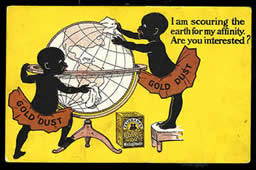 Let the Gold Dust Twins do your work for you |
Earnest Elmo Calkins- THE LOOK 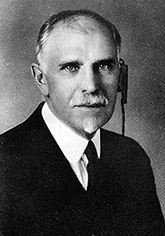
Calkin hired J.C. Leyendecker known for Saturday Evening Post illustrations to create the look of Arrow Shirts The Arrow Collar man became a symbol for a generation of college men |
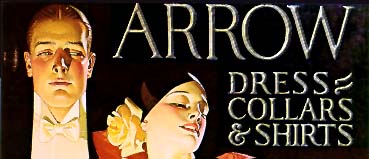 |
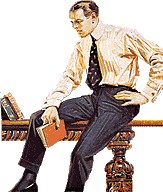 |
It turned Arrow into the largest collar/shirt brand in America. Leyendecker provided illustration for most of their advertising until 1930. Girls swooned over the images of handsome young men, all painted from models who each received mountains of fan mail each time a new face appeared in the ads. See and read more about JC Leyendecker |
Calkins developed verses promoting a clean comfortable trip on the Road of Anthracite He introduced a series about fictional Phoebe Snow's travels using a score of jingles She even found romance The campaign made Phoebe a household name and lasted 6 years Read and see more about Phoebe |
 |
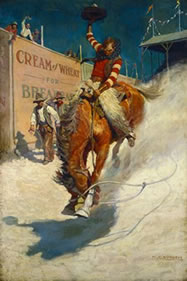 NC Wyeth Cream of Wheat |
Norman Rockwell Saturday Evening Post |
Maxfield Parish |
A Shift to Reason - Why copy
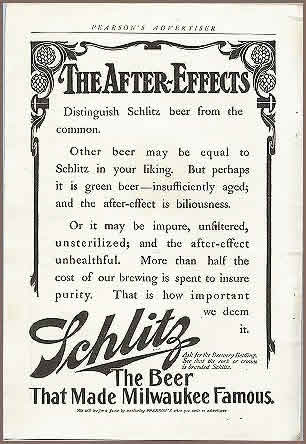 |
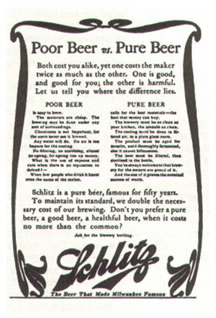 Claude Hopkins using the "preemptive claim" to establish uniqueness- it's pure |
Reason -Why and The Emotional Appeal
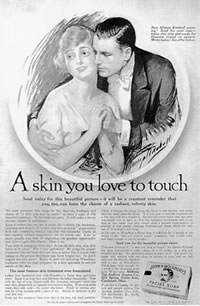 |
Helen Resor added the female point of view. Her words and visuals embraced women's hopes, fears and dreams Her ad had an editorial style that attracted attention with a gentle sell giving specific reasons to purchase often with coupons Previous to Helen's campaign the soap had been in decline for 14 years; some considered Woodbury's a lost cause. What JWT did was put 6 months into researching the brand, interviewed authorities on skin care, did consumer research. They discovered that skin care was still a new concept and women didn't know how to care for their skin. In the ads they embedded the instructions in a strong emotional appeal JWT admits they were selling "beauty and the love, envy and admiration which beauty engenders" Read and hear about some of the most influential women including Resor on Age of Persuasion http://www.cbc.ca/ageofpersuasion/2011/03/26/season-five-mad-women-the-great-women-of-advertising-1/ |
The Atmospheric Style/Impressionistic Copy
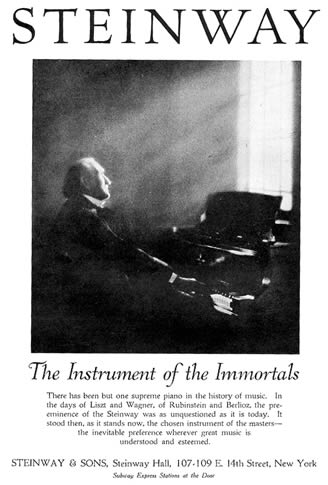 |
Raymond Rubicam used suggestive sales pitches with art, layout and impressionistic copy to convey a sense of class in this Steinway ad Read more about the campaign here http://jimsafley.com/writings_archive/steinway.html |
Expansion of Agencies/Government regulations
The Pursuit of Cleanliness -The throw-away begins
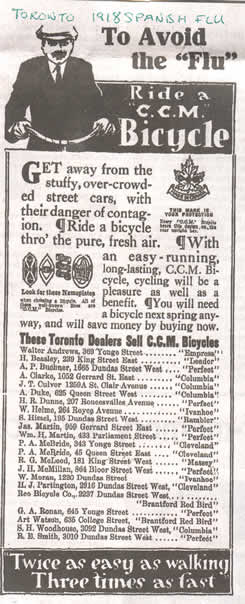
Changing the way America eats breakfast
|
Before grains were popular as a breakfast, people ate meat and potatoes; with a move to less strenuous jobs, people needed a lighter breakfast Quaker oats was already popular In 1894 Dr. John Harvey Kellogg was superintendent of the Battle Creek Sanitarium and Health Spa in Michigan. He and his brother William taught their patients to eat healthy.One evening after cooking a batch of wheat, the Kellogg brothers were called away from the kitchen. Although the dough was stale, the next morning they decided to force it though the rollers. This time instead of the long sheets of dough, thin flakes were produced. William distributed small trial boxes and used imaginative campaigns that explained their benefits Read more at Porn Flakes- John Harvey Kellogg http://www.stayfreemagazine.org/10/graham.htm The Darker side of Kellogg -The decidedly racist attitudes behind eugenics and the Race Betterment movement Dr. John Harvey Kellogg, cereal magnate was also Read more on the Eugenics movement and how poor people were sterilized in the name of so called "Betterment" http://www.stayfreemagazine.org/archives/22/eugenics-daniel-kevles.html |
Like Dr. Kellogg, Post was driven by spirituality as much as ambition; he included a pamphlet titled The Road to Wellville in every box of Grape-Nuts and claimed it could heal the sick. He also crusaded against coffee, claiming its consumption caused blindness, proved lack of character and robbed the body of energy.
Post's and Kellogg's rivalry, including lawsuits and accusations of corporate espionage, turned Battle Creek into the Silicon Valley of cereal: By 1904, 44 companies were producing cereals, each claiming more miraculous powers than the last.
The Force breakfast cereal account of Calkins & Holden's was a memorable campaign. Edward Ellsworth of Buffalo introduced Force cereal in 1901. His advertising manager, Hunter, purchased a picture and rhyme from two girls representing the transformation of the character Jim Dumps to Sunny Jim upon eating Force cereal. A campaign was launched based on these characters, and advertised on billboards, in street cars, magazines and newspapers . Calkins wrote hundreds of jingles for the nationally renowned Sunny Jim Sunny Jim made his way into popular culture in songs, marches and comedies. The company encountered financial problems a year later; they couldn't keep up with product demand read more about the Sunny Jim Force campaign athttp://en.wikipedia.org/wiki/Sunny_Jim |
 |
Telephones/electricity/appliances
 |
This ad promoted the wonders of the light bulb marketers had to explain to people that electricity was more than light- "The four walls of a kitchen no longer hold the American housewife in solitary confinement....electricity washes the dishes and clothes, cleans the house thoroughly, grinds meat, turns the ice cream freezer, runs the sewing machine and cools the house in summer. It makes coffee and toast at the dining table, does the cooking by wire in a clean, comfortable kitchen." |
The Automobile
 "For Every Need Every Day There is a Buick" |
|
Advertising and World War I
 |
The U.S.A. entered World War One in April 1917, but lost no time in producing more propaganda posters than any other nation. These encompassed recruitment to the various armed services, plus - frequently - the raising of war finance via the hugely successful liberty bond issues. Georgetown University American WWI Posters (http://www.library.georgetown.edu/dept/speccoll/guac/amposter_99/ )
|
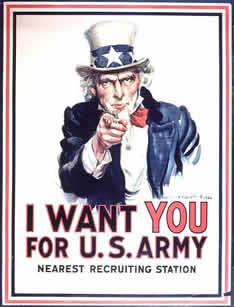 |
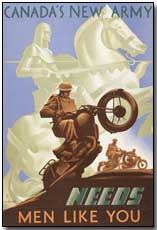 |
Canada entered the First World War along with Britain in August 1914. Canada did not have a policy of conscription - although this was (controversially) changed in time by Prime Minister Sir Robert Borden - and recruitment posters were prominent in stimulating military enlistment. Canadian WWI Propaganda Posters (http://www.firstworldwar.com/posters/canada.htm ) |
|
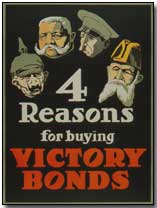 |
 |
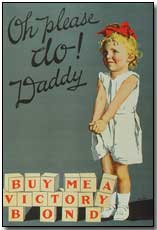 |
 |
Howard Christy painted the lovely Christy Girl for recruitment posters His posters mixed eroticism with patriotism to encourage army recruitment and support for the Liberty Loan campaigns. Christy devised a poster that would effectively lure young men into the recruitment centers. (Conscription had not yet been introduced.) The poster was an overwhelming success, becoming to the Navy what James Montgomery Flagg's "I Want You" was to the Army, and thousands of citizens enlisted in the Navy as a result of its appeal. See another Christy Girl and read an interpretation at St Lawrence University The Christy Girl was so popular she was brought back for World War II posters see more of Howard Christy's work at http://www.americanartarchives.com/christy,hc.htm |
Source:
Johnston, Russell. Selling Themselves: The Emergence of Canadian Advertising,Toronto: University of Toronto Press, 2001.
Silvulka, Juliann. Soap, Sex & Cigarettes. Belmont, CA:Wadsworth Publishing, 1998.
Reichert, Tom. The Erotic History of Advertising, New York: Prometheus Books , 2003.
O'Reilly, Terry, Age Of Persuasion: The Mad Women of Advertisin, Season 5 (2011)http://www.cbc.ca/ageofpersuasion/2011/03/26/season-five-mad-women-the-great-women-of-advertising-1/
Korn, Irene. Yes we Can Women's Networkmaintains Steadfast Dedication to Promotion and Education of Women, Adweek. April 18, 2011.
Raymond Rubicam http://ibrandmasters.com/tag/raymond-rubicam/
Kreshel, Peggy. A New View of the Invisible Woman, Research Magazine ,University of GeorgiaSpring,1993.
Lowe, James, Tim Moore Website http://www.yodaslair.com/dumboozle/tmoore/tmoordex.html Created 1997 updated 2000)
facts about 1900-1910 http://kclibrary.nhmccd.edu/decade00.html
Woodbury Soap ads analysis http://historymatters.gmu.edu/mse/ads/model.html
Toilet Paper: How America Convinced the World to Wipe http://www.neatorama.com/2011/05/19/toilet-paper-how-america-convinced-the-world-to-wipe/
Sunkist ads http://www.gono.com/museum2003/museum%20collect%20info/sunkist/sunkist.htm
History of Breakfast CBS Report http://www.cbsnews.com/stories/2008/01/28/earlyshow/living/recipes/main3758216.shtml
facts about 1910-1920 http://kclibrary.nhmccd.edu/decade10.html
Eugenics and the Race Betterment Movement http://xroads.virginia.edu/~MA03/holmgren/ppie/eug.html
Social Origins of Eugenics http://www.eugenicsarchive.org/html/eugenics/essay6text.html
Howard Christy http://www.bpib.com/illustra2/christy.htm